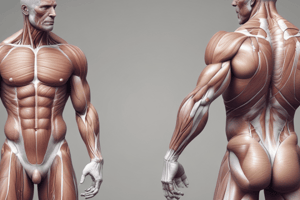Podcast
Questions and Answers
What is the main function of skeletal muscle?
What is the main function of skeletal muscle?
- Regulation of body functions
- Movement and locomotion (correct)
- Pumping blood
- Maintenance of digestive processes
What is the characteristic appearance of smooth muscle under a microscope?
What is the characteristic appearance of smooth muscle under a microscope?
- Striated (striped)
- Non-striated (smooth) (correct)
- Multinucleated
- Branching fibers
Which type of muscle is attached to bones and helps move body parts?
Which type of muscle is attached to bones and helps move body parts?
- Cardiac muscle
- Epithelial muscle
- Skeletal muscle (correct)
- Smooth muscle
What is the characteristic of cardiac muscle cells?
What is the characteristic of cardiac muscle cells?
Which type of muscle is responsible for involuntary control?
Which type of muscle is responsible for involuntary control?
What is the function of cardiac muscle?
What is the function of cardiac muscle?
Flashcards are hidden until you start studying
Study Notes
Characteristics of Muscular Tissue
- Voluntary (skeletal) and involuntary (smooth and cardiac) types
- Specialized for contraction and relaxation
- High degree of elasticity and extensibility
Types of Muscular Tissue
Skeletal Muscle (Voluntary)
- Attached to bones and helps move body parts
- Striated (striped) appearance under microscope
- Multinucleated (many nuclei)
- Voluntary control (conscious movement)
Smooth Muscle (Involuntary)
- Found in hollow organs (e.g., digestive tract, blood vessels)
- Non-striated (smooth) appearance under microscope
- Spindle-shaped cells with single nucleus
- Involuntary control (automatic movement)
Cardiac Muscle (Involuntary)
- Found in heart
- Striated appearance under microscope
- Branching fibers with single nucleus
- Involuntary control (automatic heartbeat)
Functions of Muscular Tissue
- Movement and locomotion (skeletal muscle)
- Regulation of body functions (smooth muscle)
- Pumping blood (cardiac muscle)
- Maintenance of posture and balance (skeletal muscle)
Characteristics of Muscular Tissue
- Muscular tissue is specialized for contraction and relaxation
- Has a high degree of elasticity and extensibility
- Comprises two main types: voluntary and involuntary
Types of Muscular Tissue
Skeletal Muscle (Voluntary)
- Attached to bones, enabling movement of body parts
- Displays a striated (striped) appearance under a microscope
- Consists of multinucleated cells
- Controlled voluntarily, allowing for conscious movement
Smooth Muscle (Involuntary)
- Found in hollow organs, such as the digestive tract and blood vessels
- Exhibits a non-striated (smooth) appearance under a microscope
- Composed of spindle-shaped cells with a single nucleus
- Controlled involuntarily, resulting in automatic movement
Cardiac Muscle (Involuntary)
- Exclusive to the heart, responsible for pumping blood
- Displays a striated appearance under a microscope
- Consists of branching fibers with a single nucleus
- Controlled involuntarily, regulating the heartbeat automatically
Functions of Muscular Tissue
- Enables movement and locomotion through skeletal muscle
- Regulates various body functions, such as digestion and blood pressure, via smooth muscle
- Pumps blood throughout the body through cardiac muscle
- Maintains posture and balance, thanks to skeletal muscle
Studying That Suits You
Use AI to generate personalized quizzes and flashcards to suit your learning preferences.



